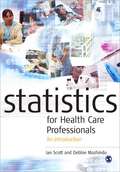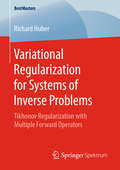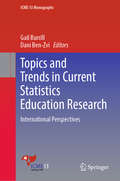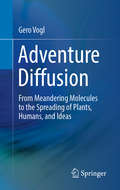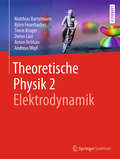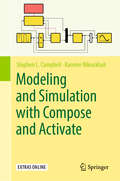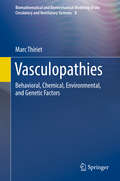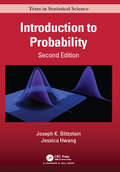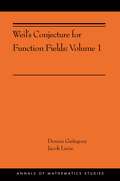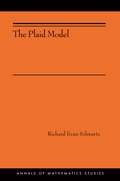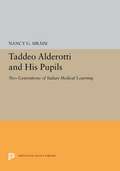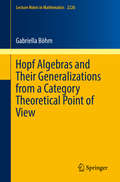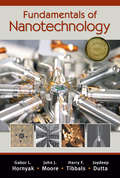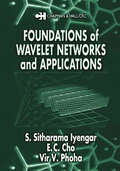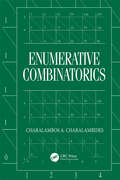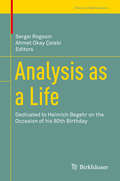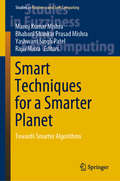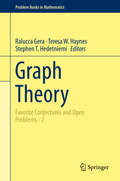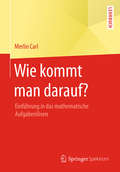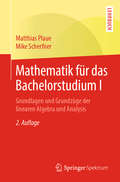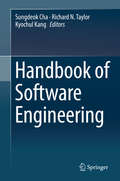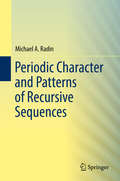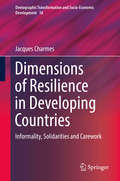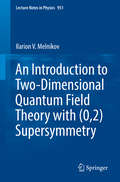- Table View
- List View
Statistics For Health Care Professionals (PDF): An Introduction
by Debbie Mazhindu Ian ScottStatistics for Health Care Professionals is an accessible guide to understanding statistics within health care practice. Focusing on quantitative approaches to investigating problems, the book introduces the basic rules and principles of statistics. Challenging the notion that statistics are often incomprehensible and complex to use, the authors begin by presenting a `how to' section explaining how specific statistical tests can be performed. They also help readers to understand the language of statistics, which is often a stumbling block for those coming to the subject for the first time. The reader is taught how to calculate statistics by hand as well as being introduced to computer packages to make life easier, and then how to analyse these results. As the results of health care research are so integral to decision-making and developing new practice within the profession, the book encourages the reader to think critically about data analysis and research design, and how these can impact upon evidence based practice. This critical stance is also crucial in the assessment of the many reports and documents issued within the health industry. Statistics for Health Care Professionals includes practical examples of statistical techniques throughout, and the exercises within and at the end of each chapter help readers to learn and to develop proficiency. There is also a glossary at the end of the book for quick and easy referencing. This book is essential reading for those coming to statistics for the first time within
Variational Regularization for Systems of Inverse Problems: Tikhonov Regularization with Multiple Forward Operators (BestMasters)
by Richard HuberTikhonov regularization is a cornerstone technique in solving inverse problems with applications in countless scientific fields. Richard Huber discusses a multi-parameter Tikhonov approach for systems of inverse problems in order to take advantage of their specific structure. Such an approach allows to choose the regularization weights of each subproblem individually with respect to the corresponding noise levels and degrees of ill-posedness.
Topics and Trends in Current Statistics Education Research: International Perspectives (ICME-13 Monographs)
by Gail Burrill Dani Ben-ZviThis book focuses on international research in statistics education, providing a solid understanding of the challenges in learning statistics. It presents the teaching and learning of statistics in various contexts, including designed settings for young children, students in formal schooling, tertiary level students, and teacher professional development. The book describes research on what to teach and platforms for delivering content (curriculum), strategies on how to teach for deep understanding, and includes several chapters on developing conceptual understanding (pedagogy and technology), teacher knowledge and beliefs, and the challenges teachers and students face when they solve statistical problems (reasoning and thinking). This new research in the field offers critical insights for college instructors, classroom teachers, curriculum designers, researchers in mathematics and statistics education as well as policy makers and newcomers to the field of statistics education. Statistics has become one of the key areas of study in the modern world of information and big data. The dramatic increase in demand for learning statistics in all disciplines is accompanied by tremendous growth in research in statistics education. Increasingly, countries are teaching more quantitative reasoning and statistics at lower and lower grade levels within mathematics, science and across many content areas. Research has revealed the many challenges in helping learners develop statistical literacy, reasoning, and thinking, and new curricula and technology tools show promise in facilitating the achievement of these desired outcomes.
Adventure Diffusion: From Meandering Molecules to the Spreading of Plants, Humans, and Ideas
by Gero VoglThis easy-to read book looks at the many ways in which diffusion bears on processes that involve dispersion, starting from the Brownian motion of molecules, covering the invasion of exotic plants, migration of populations, epidemics, and extending to the spreading of languages and ideas. Recently, there has been a growing interest in understanding migrations, diffusion and spreading outside the “hard” natural sciences of physics and chemistry, for example the spreading of plants introduced as a result of globalization. Another fascinating story is that of human migration in the distant past, i.e. the immigration of our ancestors who brought agriculture from the Near East, or the fast spread of the Palaeo-Indians into the Americas after the end of the Ice Age. Likewise, the spread of languages in the past, and even more so the current spread and retreat of languages will be described here in terms of diffusion. By understanding these principles, there is hope that some of the less common languages that are threatened by globalization can be saved. Another important implication discussed by the author concerns the outbreak of epidemics; these may be mitigated if we understand their spreading mechanism. Last but not least the spreading of ideas and innovations, a process which changes the world sometimes faster than we wish, can also be usefully described in this picture.
Theoretische Physik 2 | Elektrodynamik
by Andreas Wipf Anton Rebhan Dieter Lüst Timm Krüger Björn Feuerbacher Matthias BartelmannDas beliebte Buch Theoretische Physik wird jetzt erstmalig in korrigierter und ergänzter Form in Einzelbänden angeboten. Das ermöglicht den Studierenden, die handlichen Bände zum Lernen, Aufgabenlösen und zum schnellen Nachschlagen leichter mitnehmen und nutzen zu können. Gleichzeitig wird die gesamte theoretische Physik des Bachelorstudiums (und darüber hinaus) in den vier Bänden aufeinander abgestimmt präsentiert. Das vorliegende Buch ist der zweite Teil der vierbändigen Reihe und deckt den Lehrstoff der Bachelorvorlesung zur Elektrodynamik großer Universitäten in Deutschland, Österreich und der Schweiz möglichst umfassend ab. Die besondere Stärke dieser Reihe liegt darin, den Leser mit einer Vielzahl von didaktischen Elementen beim Lernen zu unterstützen: -Alle Kapitel werden mit grundsätzlichen Fragen eingeleitet -Wichtige Aussagen, Formeln und Definitionen sind übersichtlich hervorgehoben -Beispiele regen zum Aktivwerden an -Selbstfragen helfen dem Leser, den behandelten Stoff zu reflektieren -„So geht’s weiter“-Abschnitte, beispielsweise über nichtlineare Elektrodynamik und effektive Feldtheorien ermöglichen einen Blick über den Tellerrand und geben Einblicke in aktuelle Forschung -Anhand ausführlich gelöster Aufgaben kann das Gelernte überprüft und gefestigt werden -Mathematische Boxen sind zum schnellen Nachschlagen herausgehoben -Alle Bände sind durchgehend vierfarbig und mit übersichtlichen Grafiken gestaltet. Die Autoren haben ihre langjährige und vielfach hervorragend bewertete Lehrerfahrung in das Werk einfließen lassen. Darüber hinaus gelingt es ihnen, die Zusammenhänge in der Theoretischen Physik auch bandübergreifend klar werden zu lassen. Der Inhalt Die Maxwell-Gleichungen – Elektrostatik – Vollständige Funktionssysteme: Fourier-Transformation und Multipolentwicklung – Elektrische Felder in Materie – Magnetismus und elektrische Ströme – Ausbreitung elektromagnetischer Wellen – Optik – Relativistische Formulierung der Elektrodynamik – Abstrahlung elektromagnetischer Wellen – Lagrange- und Hamilton-Formalismus in der Elektrodynamik
Modeling and Simulation with Compose and Activate
by Ramine Nikoukhah Stephen L. CampbellThis book provides a tutorial in the use of Compose and Activate, software packages that provide system modeling and simulation facilities. Advanced system modeling software provide multiple ways of creating models: models can be programmed in specialized languages, graphically constructed as block-diagrams and state machines, or expressed mathematically in equation-based languages. Compose and Activate are introduced in this text in two parts. The first part introduces the multi-language environment of Compose and its use for modeling, simulation and optimization. The second describes the graphical system modeling and optimization with Activate, an open-system environment providing signal-based modeling as well as physical system component-based modeling. Throughout both parts are applied examples from mechanical, biological, and electrical systems, as well as control and signal processing systems. This book will be an invaluable addition with many examples both for those just interested in OML and those doing industrial scale modeling, simulation, and design. All examples are worked using the free basic editions of Activate and Compose that are available.
Vasculopathies: Behavioral, Chemical, Environmental, and Genetic Factors (Biomathematical and Biomechanical Modeling of the Circulatory and Ventilatory Systems #8)
by Marc ThirietThis volume presents one of the clinical foundations of vasculopathies: the biological markers and risk factors associated with cardiovascular disease. A detailed biological and clinical framework is provided as a prerequisite for adequate modeling. Chapter 1 presents cardiovascular risk factors and markers, where the search for new criteria is aimed at improving early detection of chronic diseases. The subsequent chapters focus on hypertension, which involves the kidney among other organs as well as many agents, hyperglycemia and diabetes, hyperlipidemias and obesity, and behavior. The last of these risk factors includes altered circadian rhythm, tobacco and alcohol consumption, physical inactivity, and diet. The volumes in this series present all of the data needed at various length scales for a multidisciplinary approach to modeling and simulation of flows in the cardiovascular and ventilatory systems, especially multiscale modeling and coupled simulations. The cardiovascular and respiratory systems are tightly coupled, as their primary function is to supply oxygen to and remove carbon dioxide from the body's cells. Because physiological conduits have deformable and reactive walls, macroscopic flow behavior and prediction must be coupled to nano- and microscopic events in a corrector scheme of regulated mechanisms. Therefore, investigation of flows of blood and air in anatomical conduits requires an understanding of the biology, chemistry, and physics of these systems together with the mathematical tools to describe their functioning in quantitative terms.
Introduction to Probability, Second Edition (Chapman & Hall/CRC Texts in Statistical Science)
by Joseph K. Blitzstein Jessica HwangDeveloped from celebrated Harvard statistics lectures, Introduction to Probability provides essential language and tools for understanding statistics, randomness, and uncertainty. The book explores a wide variety of applications and examples, ranging from coincidences and paradoxes to Google PageRank and Markov chain Monte Carlo (MCMC). Additional application areas explored include genetics, medicine, computer science, and information theory. The authors present the material in an accessible style and motivate concepts using real-world examples. Throughout, they use stories to uncover connections between the fundamental distributions in statistics and conditioning to reduce complicated problems to manageable pieces.The book includes many intuitive explanations, diagrams, and practice problems. Each chapter ends with a section showing how to perform relevant simulations and calculations in R, a free statistical software environment. The second edition adds many new examples, exercises, and explanations, to deepen understanding of the ideas, clarify subtle concepts, and respond to feedback from many students and readers. New supplementary online resources have been developed, including animations and interactive visualizations, and the book has been updated to dovetail with these resources.
Weil's Conjecture for Function Fields: Volume I (AMS-199)
by Dennis Gaitsgory Jacob LurieA central concern of number theory is the study of local-to-global principles, which describe the behavior of a global field K in terms of the behavior of various completions of K. This book looks at a specific example of a local-to-global principle: Weil’s conjecture on the Tamagawa number of a semisimple algebraic group G over K. In the case where K is the function field of an algebraic curve X, this conjecture counts the number of G-bundles on X (global information) in terms of the reduction of G at the points of X (local information). The goal of this book is to give a conceptual proof of Weil’s conjecture, based on the geometry of the moduli stack of G-bundles. Inspired by ideas from algebraic topology, it introduces a theory of factorization homology in the setting ℓ-adic sheaves. Using this theory, Dennis Gaitsgory and Jacob Lurie articulate a different local-to-global principle: a product formula that expresses the cohomology of the moduli stack of G-bundles (a global object) as a tensor product of local factors.Using a version of the Grothendieck-Lefschetz trace formula, Gaitsgory and Lurie show that this product formula implies Weil’s conjecture. The proof of the product formula will appear in a sequel volume.
The Plaid Model: (AMS-198) (Annals Of Mathematics Studies #361)
by Richard Evan SchwartzOuter billiards provides a toy model for planetary motion and exhibits intricate and mysterious behavior even for seemingly simple examples. It is a dynamical system in which a particle in the plane moves around the outside of a convex shape according to a scheme that is reminiscent of ordinary billiards. The Plaid Model, which is a self-contained sequel to Richard Schwartz’s Outer Billiards on Kites, provides a combinatorial model for orbits of outer billiards on kites.Schwartz relates these orbits to such topics as polytope exchange transformations, renormalization, continued fractions, corner percolation, and the Truchet tile system. The combinatorial model, called “the plaid model,” has a self-similar structure that blends geometry and elementary number theory. The results were discovered through computer experimentation and it seems that the conclusions would be extremely difficult to reach through traditional mathematics.The book includes an extensive computer program that allows readers to explore the materials interactively and each theorem is accompanied by a computer demonstration.
Taddeo Alderotti and His Pupils: Two Generations of Italian Medical Learning (Princeton Legacy Library #5467)
by Nancy G. SiraisiTaddeo Alderotti was the most celebrated professor of medicine at Bologna in the late thirteenth century. His teaching involved close attention not merely to medicine itself but to all the scientific and philosophical learning of the time. His pupils, in turn, included some of the leading learned physicians in Italy in the early fourteenth century. In a study of the professional thought and practice of these physicians, Nancy Siraisi shows how their intellectual and medical achievements were integrated with the soical and institutional context within which they lived.Focusing specifically on Taddeo Alderotti and six of his pupils, the author treats what is known of their lives, their teaching activites, their learned writings, their medical practice, and their broader moral outlook. She pays particular attention to the theoretical concepts of meidcal learning, the relationship of medicine to natural philosophy, the correlation of medical theory to medical practice, and the role of the physician as a citizen.Nancy G. Siraisi is Professor of History at Hunter College of the City University of New York.Originally published in 1981.The Princeton Legacy Library uses the latest print-on-demand technology to again make available previously out-of-print books from the distinguished backlist of Princeton University Press. These editions preserve the original texts of these important books while presenting them in durable paperback and hardcover editions. The goal of the Princeton Legacy Library is to vastly increase access to the rich scholarly heritage found in the thousands of books published by Princeton University Press since its founding in 1905.
Hopf Algebras and Their Generalizations from a Category Theoretical Point of View (Lecture Notes in Mathematics #2226)
by Gabriella BöhmThese lecture notes provide a self-contained introduction to a wide range of generalizations of Hopf algebras. Multiplication of their modules is described by replacing the category of vector spaces with more general monoidal categories, thereby extending the range of applications. Since Sweedler's work in the 1960s, Hopf algebras have earned a noble place in the garden of mathematical structures. Their use is well accepted in fundamental areas such as algebraic geometry, representation theory, algebraic topology, and combinatorics. Now, similar to having moved from groups to groupoids, it is becoming clear that generalizations of Hopf algebras must also be considered. This book offers a unified description of Hopf algebras and their generalizations from a category theoretical point of view. The author applies the theory of liftings to Eilenberg–Moore categories to translate the axioms of each considered variant of a bialgebra (or Hopf algebra) to a bimonad (or Hopf monad) structure on a suitable functor. Covered structures include bialgebroids over arbitrary algebras, in particular weak bialgebras, and bimonoids in duoidal categories, such as bialgebras over commutative rings, semi-Hopf group algebras, small categories, and categories enriched in coalgebras. Graduate students and researchers in algebra and category theory will find this book particularly useful. Including a wide range of illustrative examples, numerous exercises, and completely worked solutions, it is suitable for self-study.
Fundamentals of Nanotechnology
by Gabor L. Hornyak John J. Moore H. F. Tibbals Joydeep DuttaWINNER 2009 CHOICE AWARD OUTSTANDING ACADEMIC TITLE! Nanotechnology is no longer a subdiscipline of chemistry, engineering, or any other field. It represents the convergence of many fields, and therefore demands a new paradigm for teaching. This textbook is for the next generation of nanotechnologists. It surveys the field’s broad landscape, exploring the physical basics such as nanorheology, nanofluidics, and nanomechanics as well as industrial concerns such as manufacturing, reliability, and safety. The authors then explore the vast range of nanomaterials and systematically outline devices and applications in various industrial sectors. This color text is an ideal companion to Introduction to Nanoscience by the same group of esteemed authors. Both titles are also available as the single volume Introduction to Nanoscience and Nanotechnology Qualifying instructors who purchase either of these volumes (or the combined set) are given online access to a wealth of instructional materials. These include detailed lecture notes, review summaries, slides, exercises, and more. The authors provide enough material for both one- and two-semester courses.
Foundations of Wavelet Networks and Applications
by S. Sitharama Iyengar V. V. PhohaTraditionally, neural networks and wavelet theory have been two separate disciplines, taught separately and practiced separately. In recent years the offspring of wavelet theory and neural networks-wavelet networks-have emerged and grown vigorously both in research and applications. Yet the material needed to learn or teach wavelet networks has remained scattered in various research monographs.Foundations of Wavelet Networks and Applications unites these two fields in a comprehensive, integrated presentation of wavelets and neural networks. It begins by building a foundation, including the necessary mathematics. A transitional chapter on recurrent learning then leads to an in-depth look at wavelet networks in practice, examining important applications that include using wavelets as stock market trading advisors, as classifiers in electroencephalographic drug detection, and as predictors of chaotic time series. The final chapter explores concept learning and approximation by wavelet networks.The potential of wavelet networks in engineering, economics, and social science applications is rich and still growing. Foundations of Wavelet Networks and Applications prepares and inspires its readers not only to help ensure that potential is achieved, but also to open new frontiers in research and applications.
Enumerative Combinatorics (Discrete Mathematics and Its Applications)
by Charalambos A. CharalambidesEnumerative Combinatorics presents elaborate and systematic coverage of the theory of enumeration. The first seven chapters provide the necessary background, including basic counting principles and techniques, elementary enumerative topics, and an extended presentation of generating functions and recurrence relations. The remaining seven chapters focus on more advanced topics, including, Stirling numbers, partitions of integers, partition polynomials, Eulerian numbers and Polya's counting theorem.Extensively classroom tested, this text was designed for introductory- and intermediate-level courses in enumerative combinatorics, but the far-reaching applications of the subject also make the book useful to those in operational research, the physical and social science, and anyone who uses combinatorial methods. Remarks, discussions, tables, and numerous examples support the text, and a wealth of exercises-with hints and answers provided in an appendix--further illustrate the subject's concepts, theorems, and applications.
Analysis as a Life: Dedicated to Heinrich Begehr on the Occasion of his 80th Birthday (Trends in Mathematics)
by Sergei Rogosin Ahmet Okay ÇelebiThis is a book comprising selected papers of colleagues and friends of Heinrich Begehr on the occasion of his 80th birthday. It aims at being a tribute to the excellent achievements of Heinrich Begehr in complex analysis and complex differential equations, and especially to his prominent role as one of the creators and long-time leader of the International Society for Analysis, its Applications and Computation (ISAAC).
Smart Techniques for a Smarter Planet: Towards Smarter Algorithms (Studies in Fuzziness and Soft Computing #374)
by Manoj Kumar Mishra Bhabani Shankar Mishra Yashwant Singh Patel Rajiv MisraThis book is intended to provide a systematic overview of so-called smart techniques, such as nature-inspired algorithms, machine learning and metaheuristics. Despite their ubiquitous presence and widespread application to different scientific problems, such as searching, optimization and /or classification, a systematic study is missing in the current literature. Here, the editors collected a set of chapters on key topics, paying attention to provide an equal balance of theory and practice, and to outline similarities between the different techniques and applications. All in all, the book provides an unified view on the field on intelligent methods, with their current perspective and future challenges.
Graph Theory: Favorite Conjectures And Open Problems - 1 (Problem Books in Mathematics)
by Stephen T. Hedetniemi Teresa W. Haynes Ralucca GeraThis second volume in a two-volume series provides an extensive collection of conjectures and open problems in graph theory. It is designed for both graduate students and established researchers in discrete mathematics who are searching for research ideas and references. Each chapter provides more than a simple collection of results on a particular topic; it captures the reader’s interest with techniques that worked and failed in attempting to solve particular conjectures. The history and origins of specific conjectures and the methods of researching them are also included throughout this volume. Students and researchers can discover how the conjectures have evolved and the various approaches that have been used in an attempt to solve them. An annotated glossary of nearly 300 graph theory parameters, 70 conjectures, and over 600 references is also included in this volume. This glossary provides an understanding of parameters beyond their definitions and enables readers to discover new ideas and new definitions in graph theory. The editors were inspired to create this series of volumes by the popular and well-attended special sessions entitled “My Favorite Graph Theory Conjectures,” which they organized at past AMS meetings. These sessions were held at the winter AMS/MAA Joint Meeting in Boston, January 2012, the SIAM Conference on Discrete Mathematics in Halifax in June 2012, as well as the winter AMS/MAA Joint Meeting in Baltimore in January 2014, at which many of the best-known graph theorists spoke. In an effort to aid in the creation and dissemination of conjectures and open problems, which is crucial to the growth and development of this field, the editors invited these speakers, as well as other experts in graph theory, to contribute to this series.
Wie kommt man darauf?: Einführung in das mathematische Aufgabenlösen
by Merlin CarlDas Buch soll Studierende der Mathematik und verwandter Disziplinen in grundlegende Techniken und Prinzipien des selbstständigen mathematischen Aufgabenlösens einführen. Dazu werden zunächst konkrete Beweisprinzipien wie das Schubfachprinzip, Invarianten, Induktion oder Rückwärtsarbeiten anhand von Beispielen und ausführlichen Erläuterungen eingeführt, ehe zu allgemeineren Strategien wie Beobachtung und Mustererkennung, Verallgemeinerung, Spezialisierung und Analogie übergegangen wird. Bei den Lösungen zu den zahlreichen Beispielaufgaben liegt der Schwerpunkt auf der Erklärung, wie man auf die jeweiligen Beweisschritte selbst hätte kommen können. Die so erlernten Strategien werden dann in verschiedenen mathematischen Gebieten erprobt, nämlich der elementaren Zahlentheorie, der Graphentheorie, der endlichen Kombinatorik, der linearen Algebra und der Analysis. Jedes Kapitel schließt mit zahlreichen Übungsaufgaben.
Mathematik für das Bachelorstudium I: Grundlagen und Grundzüge der linearen Algebra und Analysis
by Matthias Plaue Mike ScherfnerDies ist ein Buch über die Mathematik, welches insbesondere die Anforderungen des Bachelorstudiums sinnvoll bedient. Es behandelt die Grundlagen und danach den Stoff der linearen Algebra und eindimensionalen Analysis. Damit deckt es den Stoff ab, der an Universitäten wesentlich im ersten Semester behandelt wird. Dabei wenden wir uns an Physiker, Mathematiker sowie ambitionierte Lehramtskandidaten und Ingenieure.Hiermit liegt der erste Band einer dreiteiligen Reihe vor, welche die Themen beinhaltet, die gewöhnlich Inhalt der Basisvorlesungen sind; darüber hinaus werden im letzten Band Grundlagen für das Beherrschen von weiteren Themen in Spezialvorlesungen geboten. Es liegt also eine konsistente Reihe für wichtige Teile der mathematischen Ausbildung vor.Das Buch fördert sowohl das Verständnis als auch das konzentrierte Lernen für Klausuren und mündliche Prüfungen.Die Autoren bringen ihre Erfahrungen aus zahlreichen erfolgreichen Vorlesungen und Übungen zum Nutzen der Studierenden ein.Auf einen Blick:Klarer Stil, klare Sprache, klare Struktur.Zahlreiche Erläuterungen.Zu jedem Thema wird gesondert ein informativer Ein- und Ausblick geliefert.Grafiken und viele Beispiele helfen beim Verstehen.Fragen zum Selbsttest unterstützen zusätzlich beim Lernen.Aufgaben mit vollständigen Lösungen dienen der Vertiefung und Vorbereitung auf Prüfungen jeglicher Art.Das Buch ist für die zweite Auflage komplett durchgesehen und um zahlreiche Aufgaben mit Lösungen ergänzt.
Handbook of Software Engineering
by Sungdeok Cha Richard N. Taylor Kyochul KangThis handbook provides a unique and in-depth survey of the current state-of-the-art in software engineering, covering its major topics, the conceptual genealogy of each subfield, and discussing future research directions. Subjects include foundational areas of software engineering (e.g. software processes, requirements engineering, software architecture, software testing, formal methods, software maintenance) as well as emerging areas (e.g., self-adaptive systems, software engineering in the cloud, coordination technology). Each chapter includes an introduction to central concepts and principles, a guided tour of seminal papers and key contributions, and promising future research directions. The authors of the individual chapters are all acknowledged experts in their field and include many who have pioneered the techniques and technologies discussed.Readers will find an authoritative and concise review of each subject, and will also learn how software engineering technologies have evolved and are likely to develop in the years to come. This book will be especially useful for researchers who are new to software engineering, and for practitioners seeking to enhance their skills and knowledge.
Periodic Character and Patterns of Recursive Sequences
by Michael A. RadinThis textbook on periodic character and patterns of recursive sequences focuses on discrete periodic patterns of first order, second order and higher order difference equations. Aimed toward advanced undergraduate students and graduate students who have taken a basic course in Calculus I and Discrete Mathematics, this book serves as a core text for a course in Difference Equations and Discrete Dynamical Systems. The text contains over 200 exercises to provide readers with a hands-on experience working with the material; the exercises include computations of specific examples and proofs of general results. Readers will receive a first-hand introduction to patterns of periodic cycles and patterns of transient terms with exercises for most sections of the text, preparing them for significant research work in the area.
Dimensions of Resilience in Developing Countries: Informality, Solidarities and Carework (Demographic Transformation and Socio-Economic Development #10)
by Jacques CharmesThis book provides the latest empirical data on the three forms of resilience: informality, solidarities and unpaid care-work. It uncovers and quantifies these three forms of resilience that are generally invisible or ill recognised, whereas these play a major role in the livelihoods of poor and vulnerable populations. The book shows how the slow but constant unveiling of these forms over the past four decades has gradually changed our vision of progress and development and is impacting the norms and concepts that shape our vision of the economy and society. The book also emphasizes the role of informal economy through explaining the origins of the concept, its definitions and the methods of data collection and measurement. As such the book will be of interest to students, researchers and policy makers in population studies, economics, and international development.
An Introduction to Two-Dimensional Quantum Field Theory with (Lecture Notes in Physics #951)
by Ilarion V. MelnikovThis book introduces two-dimensional supersymmetric field theories with emphasis on both linear and non-linear sigma models. Complex differential geometry, in connection with supersymmetry, has played a key role in most developments of the last thirty years in quantum field theory and string theory. Both structures introduce a great deal of rigidity compared to the more general categories of non-supersymmetric theories and real differential geometry, allowing for many general conceptual results and detailed quantitative predictions. Two-dimensional (0,2) supersymmetric quantum field theories provide a natural arena for the fruitful interplay between geometry and quantum field theory. These theories play an important role in string theory and provide generalizations, still to be explored fully, of rich structures such as mirror symmetry. They also have applications to non-perturbative four-dimensional physics, for instance as descriptions of surface defects or low energy dynamics of solitonic strings in four-dimensional supersymmetric theories. The purpose of these lecture notes is to acquaint the reader with these fascinating theories, assuming a background in conformal theory, quantum field theory and differential geometry at the beginning graduate level. In order to investigate the profound relations between structures from complex geometry and field theory the text begins with a thorough examination of the basic structures of (0,2) quantum field theory and conformal field theory. Next, a simple class of Lagrangian theories, the (0,2) Landau-Ginzburg models, are discussed, together with the resulting renormalization group flows, dynamics, and symmetries. After a thorough introduction and examination of (0,2) non-linear sigma models, the text introduces linear sigma models that, in particular, provide a unified treatment of non-linear sigma models and Landau-Ginzburg theories. Many exercises, along with discussions of relevant mathematical notions and important open problems in the field, are included in the text.
